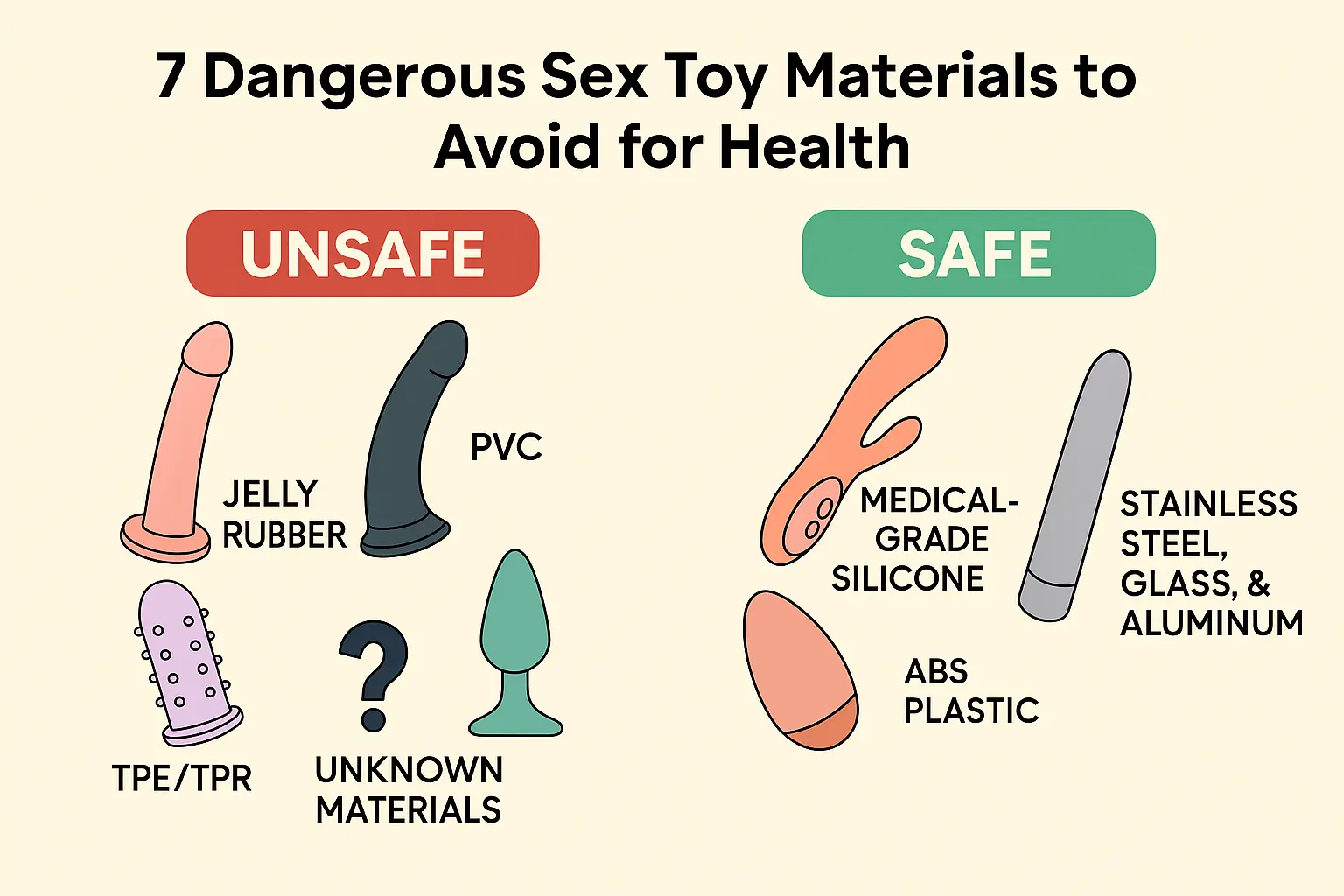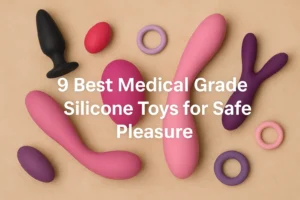Let’s be real for a sec — most people don’t even think about what their sex toys are made of. I didn’t either. Not at first. When I bought my first toy, I was way more focused on “Will this actually get me off?” than “Is this safe to put in my body?”
And that’s totally normal, right? We’re sold on the fantasy, the promise of pleasure, the sleek design in the ad. But here’s the thing: not all sex toys are created equal. And some? Straight-up sketchy. It’s like buying food without checking the ingredients, but way more intimate.
So, if you’re using toys made with certain materials, you could be risking your health without even knowing it. Yikes, right? We’re talking about things that can mess with your body in some pretty unwelcome ways, from minor irritations to, well, more serious stuff. It’s a conversation worth having, and trust me, it’s not about fear-mongering. It’s about empowerment. It’s about knowing better so you can do better.
In this post, I’m going to walk you through the sex toy materials to avoid for health, why they’re risky, and what to look for instead. I’ll also share some safer, body-friendly alternatives (including a few I’ve personally tried and loved), and point you to trusted brands that actually care about your well-being.
Let’s talk pleasure — the healthy, empowered kind.
Table of Content
Why Material Matters (Seriously, It’s Not Just Marketing)
Ever heard of “body-safe” sex toys? It’s not just a buzzword. It’s a crucial standard that separates a fun, healthy experience from a potentially harmful one, especially when you consider the sex toy materials to avoid for health. Some toys are made with cheap, porous materials that can harbor bacteria, release toxic chemicals, or cause irritation — especially if you’ve got sensitive skin or use them frequently (hi, same).
Non-body-safe toys can lead to:
Yeast infections or bacterial vaginosis (BV): Porous materials, as we’ll discuss, are like a playground for bacteria and fungi. Even with diligent cleaning, microscopic nasties can hide in the tiny crevices, leading to an unwanted infection.
Irritation or burning: The chemicals in some cheap toys can cause a contact dermatitis reaction, leaving your skin red, itchy, or burning. Your intimate areas are incredibly sensitive, and they absorb substances far more readily than the skin on your arm.
Hormonal disruption: This is the big one. Many of the materials on our “naughty list” contain something called phthalates, which are endocrine disruptors. In simple terms, these chemicals can mimic or interfere with your body’s hormones. Studies have linked exposure to phthalates with a range of concerns, from reproductive issues to developmental problems. It’s a serious issue, and frankly, it’s not a risk worth taking for a moment of pleasure.
Non-body-safe toys can lead to yeast infections, irritation, or hormonal disruption. In fact, a 2023 study published in Microplastics and Nanoplastics revealed that many sex toys can release microplastics and phthalates at concerning levels, even when used as directed. In simulated abrasion tests, these chemicals appeared in amounts exceeding safety thresholds—a clear warning that material really matters.
In short: your vagina deserves better. Your whole body does.
So, what should you avoid?
Sex Toy Materials to Avoid for Health
This is the list of sex toy materials to avoid for health that you need to keep handy when you’re online shopping or Browse a store.
1. Jelly Rubber (a.k.a. Jelly Toys)
You’ll find these everywhere — usually brightly colored, super squishy, and dirt cheap. They’re often the first toys people buy because the price tag is so appealing. But don’t let that price tag fool you. It’s cheap for a reason.
Jelly toys are typically made with PVC and packed with phthalates. That distinct, plastic-y smell, kind of like a new beach ball? That’s a red flag right there. It’s the smell of chemical leeching. It’s an honest-to-goodness warning sign that the material is not stable.
Also: jelly is incredibly porous. Think of it like a hard sponge. That means even if you think you’re cleaning it, bacteria can still hide out in the material. Gross. No amount of soap and water is going to get rid of the bacteria that’s already settled deep inside. In my experience, these toys never feel truly clean, and that’s not a feeling you want during or after a good session.
🧠 Pro Tip: If you already have a jelly toy, cover it with a condom before use — but honestly, it’s better to toss it and upgrade. Your body will thank you. Curious about how jelly compares to other materials? You’ll love Silicone vs Jelly Sex Toys: What’s Safe & What to Avoid.
2. PVC (Polyvinyl Chloride)
PVC is the base material for most jelly toys. It’s a type of hard plastic that needs softening chemicals (like phthalates) to make it flexible. It’s a common material used in pipes and flooring, so maybe that tells you everything you need to know about putting it inside your body! The problem is that these softening chemicals are not permanently bound to the plastic and can leach out over time.
You’ll often find PVC in “realistic” dildos or toys that are designed to feel very firm and rubbery. The material itself is not just a chemical concern, but a porous one. Bacteria loves that. Your body? Not so much. Honestly, I’ve found that toys made with PVC never feel quite right anyway. Too rubbery. Too chemically. You can almost feel the difference in texture and smell.
3. TPE/TPR (Thermoplastic Elastomers/Rubber)
These are often marketed as “soft,” “real-feel,” or even “body-safe,” which sounds great — until you realize that many of them are still porous and can degrade over time. TPE is a popular material for sleeves, strokers, and textured toys because of its soft, skin-like feel. However, like jelly, it absorbs lube, fluids, and bacteria like a sponge.
Manufacturers sometimes call them “hypoallergenic” or “phthalate-free” — but unless they’re medical-grade and explicitly non-porous, you’re better off skipping them. A true medical-grade TPE is non-porous and perfectly safe, but those are rarely the ones you’ll find for a few dollars.
Real Talk: I once had a TPR toy that got sticky after a few months. Not sticky from lube — just… weird. It was like the material itself was breaking down. No matter how much I cleaned it, it just felt gross. Into the trash it went. That’s a perfect example of why you need to be careful with sex toy materials to avoid for health that aren’t medical-grade.
4. Latex (for toys, not condoms)
Most people are familiar with latex as a condom material, but it’s also used in some older or less-common toys. Some people have a latex allergy — and when it comes to internal toys, that’s not a surprise you want mid-session. Even if you’re not allergic, latex toys can break down easily, especially with oil-based lubes, which are a no-go anyway. Plus, they’re rarely labeled clearly, so you might not even know you’re using one. It’s better to stick with safer, more durable alternatives.
5. Unknown or Unlabeled Materials
This is the scariest category, honestly. If a toy doesn’t list what it’s made of, don’t trust it. Period. A surprising number of products — especially those from sketchy online shops or super cheap brands — come with zero info about materials. If a toy is just listed as “plastic” or “rubber” or has no material information at all, you have to assume it’s made from the cheapest, most questionable stuff out there.
If a manufacturer isn’t proud enough to say what their product is made of, they’re probably hiding something. Don’t take that risk.
Want real, safe options without guessing? Check out The Best Affordable Body Safe Dildos — it’s got honest reviews, personal picks, and no shady ingredients.
Safer Sex Toy Materials to Choose Instead
Okay, let’s talk better choices. These are the materials you do want in your nightstand. They’re durable, easy to clean, and, most importantly, they won’t mess with your health.
1. Medical-Grade Silicone
This is the gold standard, the MVP of toy materials. It’s what all the best toys are made from for a reason. It’s:
Non-porous: No hiding spots for bacteria, making it super hygienic.
Hypoallergenic: It’s a great choice for sensitive skin.
Easy to clean: A quick wash with soap and water or a dedicated toy cleaner is all it takes.
Soft but firm in all the right ways: Silicone comes in different firmness levels, from firm and supportive to soft and squishy, and feels amazing.
Safe for internal and external use: It’s a versatile material that works for every kind of toy.
If you’ve never tried a true silicone toy, do yourself a favor. The difference in feel and hygiene is genuinely a total game-changer. My current fave? The non-toxic Pearl 2+ vibrator from Kiiroo — it’s body-safe, super sleek, and feels amazing. I also love Dame and We-Vibe for their high-quality silicone products.
2. ABS Plastic
Sounds industrial, but it’s actually super common and body-safe when used correctly. ABS plastic is non-porous, durable, and easy to sanitize. You’ll find it often used in bullet vibrators, wands, and the bases of toys. It’s also often used for waterproof casing, making toys fully submersible. Just make sure the surface that touches your body isn’t coated in anything sketchy and that any attached “pleasure parts” are made of silicone.
3. Stainless Steel, Borosilicate Glass, and Aluminum
These materials are fantastic for a few reasons. They’re:
Body-safe: Completely non-porous and easy to sterilize. You can even boil them!
Long-lasting: These toys will essentially last you a lifetime.
Great for temperature play: You can warm them up in hot water or cool them down in the fridge for a whole new sensation.
Steel and glass can feel quite intense, so they’re often better for more experienced users — but wow, they’re a game-changer once you get comfy with them. My first glass toy was an incredible experience that really opened my eyes to the world of temperature play.
My First “Toxic” Toy (and What I Wish I Knew Sooner)
I still remember my first-ever toy — a jelly rabbit vibe from a random online store. It was pink, squishy, and smelled like a new car tire. I didn’t know any better about the sex toy materials to avoid for health. It was cheap, it looked cute, so I bought it.
I used it a few times and started getting a nagging irritation that wouldn’t go away. It felt itchy and just… off. No matter how much I cleaned it, it just didn’t feel right. Turns out, that “rubbery” material was packed with phthalates and was a breeding ground for bacteria. Ugh. It was a miserable experience that soured me on toys for a little while.
When I finally switched to a proper, medical-grade silicone toy, I was honestly shocked at the difference. No more weird smells. No burning. Just pure pleasure and peace of mind. It was a lesson in how important it is to prioritize your health, and it’s why I’m so passionate about this topic now.
How to Shop Smart: Look for These Signs
When you’re picking a toy, keep these tips in mind about sex toy materials to avoid for health:
Read the label: If a product doesn’t say what it’s made of, skip it. A reputable brand will proudly list their materials.
Look for specific terms: Search for “medical-grade silicone,” “phthalate-free,” or “non-porous.” These are all positive indicators.
Stick to trusted brands: Brands like Kiiroo, Dame, We-Vibe, and Lelo have built a reputation on using high-quality, body-safe materials. They’re a safer bet than an unknown brand on a third-party marketplace.
Price matters: A $10 “silicone” dildo is probably not the real deal. High-quality silicone is more expensive to produce. If a price seems too good to be true, it probably is.
Feel the product (if possible): A true silicone toy will feel soft, smooth, and maybe a little “tacky” to the touch (but not sticky). It won’t have that strong chemical odor.
Read reviews: Check what other people are saying, especially about the material and how the toy has held up over time.
Want help choosing your first body-safe couples toy? This Beginner Couples Toy Guide has you covered.
Final Thoughts: Your Body Deserves Better
Let’s stop settling for cheap, shady sex toys. Your body, your pleasure, your health — it all matters. The beautiful thing is that you no longer have to sacrifice one for the other. There are so many safe, high-quality options out there now. Whether you’re into vibes, dildos, or couple toys, you don’t have to compromise on safety for satisfaction.
And once you go body-safe? Trust me, you won’t go back. Making informed choices about the sex toy materials to avoid for health isn’t just about being cautious; it’s about giving yourself permission to have the best, healthiest, and most confident intimate experiences possible. It’s an act of self-care.
FAQs: Sex Toy Materials to Avoid for Health
Q: Are jelly sex toys really that dangerous? Yes, especially long-term. They’re porous and often contain phthalates — chemicals that can mess with hormones and irritate sensitive areas. When you’re looking for sex toy materials to avoid for health, jelly is always at the top of the list.
Q: How do I know if a toy is body-safe? Check the material. Look for “medical-grade silicone,” “non-porous,” or “phthalate-free.” A reputable brand will always be transparent about its materials. If it doesn’t say? Don’t use it.
Q: Can I use a condom over unsafe toys to make them safer? Temporarily, yes — but that’s not a long-term fix. Condoms can help with bacteria but won’t block all chemical leaching. It’s a stop-gap measure, but the best solution is to get rid of the unsafe toy.
Q: What’s the safest sex toy material for beginners? Medical-grade silicone is the best bet. It’s safe, smooth, easy to clean, and doesn’t have the health concerns associated with sex toy materials to avoid for health.
Q: Where can I find body-safe toys that are also affordable? You don’t have to break the bank. There are many affordable, body-safe options from trusted brands. This guide on Best Non-Toxic Female Masturbation Toys has some great picks that won’t compromise your health or your wallet.
Q: Is “silicone-feel” the same as real silicone? Absolutely not. This is a common marketing trick. “Silicone-feel” often refers to a coating on a non-body-safe material, which can peel or degrade over time, exposing you to the underlying unsafe material. Always look for “100% silicone” or “medical-grade silicone.”
Q: Why do some companies still sell unsafe toys? Mostly because they are cheap to produce and sell. The lack of regulation in the industry means they can get away with it. However, the rise of conscious consumerism is changing this, with more brands now focusing on health and transparency.
Q: What should I do if I think I’ve had a bad reaction to a sex toy? Stop using the toy immediately. If you have any irritation, burning, or signs of infection, consult a doctor or a sexual health expert. Your health is always the top priority.




